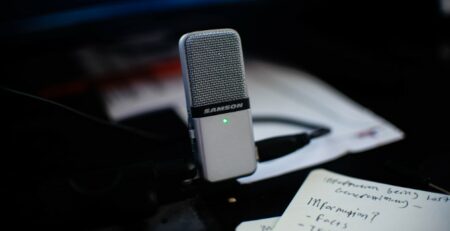What is Foley? What is Foley's Role in Sound Design?
In visual media productions such as movies, television and video games, sound designis a critical tool for enriching the viewer's experience and telling the story more effectively. of sound design A very important part of it is the “foley”. So what is foley and what role does it play in sound design?
What is Foley?
Foley is the process of creating live sound effects. It takes its name from Jack Foley, who pioneered this field. It usually takes place in post-production and includes sound effects accompanying physical actions in a movie or TV show. Foley artists, It simulates the sounds of characters walking, doors opening and closing, glasses colliding, or any object falling. These are usually performed in the studio, using a variety of objects and materials.
Foley can be defined as the process of “applying effects”. The sounds of people and things that we mentioned in the effects section were synchronized with the on-screen action by the “foley artists” in the studio.r. Meanwhile, the artists create the sound effects by repeating the movements of the actors in the movie with similar items. These actions include footsteps, clothing movements, and other auxiliary sounds. Therefore, foley studios have a variety of items, shoes and clothes, different surfaces such as wood, marble, pebbles for footsteps, bathtubs or children's pools for water effects, and many more items and tools. The name of the technique comes from the surname of Jack Foley, an editor in Hollywood in the 1940s.ir.
For a better understanding of the Foley technique, you can refer to the links below. In these links, you can see behind-the-scenes footage and foley studio designs of the effects applied in Hollywood.
Foley's Role in Sound Design
in sound design foley is an important technique that enhances the atmosphere and realism of a production. It allows the viewer to feel a scene more deeply and helps set the overall emotional tone of the story.
Foley, of sound design plays a specialized role in its broad spectrum. Foley is often added in post-production, while other audio elements such as dialogue and music are usually recorded at other stages of production.
sound design and foley, It is a powerful component of storytelling and vital to the success of a media production. Foley is a magical component of sound design with the ability to bring life to any scene. To understand the question 'what is Foley' more deeply, a production's of sound design allows us to appreciate its complexity and expressiveness.
Sound Design and Foley: Two Similar but Different Sound Techniques
Sound design and foleyare integral parts of visual media productions. Both enhance storytelling and enrich the audience experience through the use of sound. However, sound design and foley is not the same thing. Understanding the differences between these two terms will help you better understand the overall sound design process of a production.
Sound Design: A Broad Art
sound designcovers the entire sound spectrum of a production. A sound designer sets the emotional tone and atmosphere of a movie, television show, or video game. This includes dialogue, music, sound effects, background sounds, and yes, a host of audio elements including foley. Sound design combines and arranges these sounds to create the overall emotional impact of a particular scene or scenes.
Foley: Live Sound Effects
Foley, of sound design is a particular aspect. A foley artist creates the sound effects of a production live, often in post-production. These sounds are often paired with physical actions that appear in the movie or TV show. For example, the sound of a character walking can be created by hitting an object in their hand or walking on a surface.
Sound Design and Foley Are Different, But Working Together
Sound design and foleyare two different techniques that work together in a media production. Both focus on the use of the voice but emphasize its different aspects. sound design, responsible for the overall sound editing of a production, whereas Foley focuses on the creation of more specific, detailed sound effects. Therefore, sound design and foley are not the same thing, but both play critical roles in establishing the overall soundscape of a production.
Sound design and foley Sounds can be examined under 3 headings;
- Music
- human voices
- Effects
What is the Music Influence for Foley?
in sound design, foley and music work together to precisely increase the emotional depth of a visual media production. So, “What is the musical influence for Foley?” Foley represents the sound effects that enliven the physical reality of a production, while the music sets the emotional tone and atmosphere of the scene. When these two sound elements combine, they further enrich the audience experience. Music drives the audience's emotional response, and foley adds realism to the scene and embodies it. It appears that music affects how foley effects are perceived, a fast-paced or tense piece of music can make foley effects more dramatic or immediate. Also, because music and foley effects are often mixed together, how much the music highlights or obscures the foley sounds determines the overall sound balance and atmosphere of the scene.
These voices may appear in TV series/films as conversations between characters, conversations with themselves or as an external voice. Although there are films with exceptions, they are the indispensable sounds of TV series/films today. Foley is the art of creating live sound effects of physical movements in visual media productions, but the role of human voices is also important.. The effect of human voices on Foley is that they add depth and realism to the production. For example, sounds of breathing, coughing, sobbing or screaming can better convey to the audience the emotional state of the character and his current action. These little details play a critical role in determining the overall atmosphere of a scene and the audience's emotional reaction to the characters. Therefore, the influence of human voices in the foley process is a powerful tool that deepens the realism of a production and the viewer's experience.
Foley brings authenticity and realism to media productions, and the use of effects is vital in the process. Foley's influence on effects can profoundly affect the atmosphere and dynamics of a scene. Effects can be various sounds created to support a particular action or situation, such as a door slam, glass breaking, or starting a car engine. These sounds help the audience feel the realism of the scene and tell the story more concretely and effectively. Therefore, the impact of effects on foley can greatly improve the quality of storytelling and the audience experience.
The Role and Effect of Human Voices in Foley's Art
Foley is the art of creating live sound effects of physical movements in visual media productions, but the role of human voices is also important. The effect of human voices on Foley is that they add depth and realism to the production. For example, sounds of breathing, coughing, sobbing or screaming can better convey to the audience the emotional state of the character and his current action. These little details play a critical role in determining the overall atmosphere of a scene and the audience's emotional reaction to the characters. Therefore, the influence of human voices in the foley process is a powerful tool that deepens the realism of a production and the viewer's experience.
Foley art occupies a prominent place in the voice-over industry and plays a vital role in film, television, video games and other media forms. The inclusion of human voices in this process adds great depth to the atmosphere of a scene and the audience's experience.
- Foley and the Voices: The effect of human voices on Foley is to increase a production's sense of realism. For example, sounds like a character's breathing, coughing, sobbing or screaming convey the action in the scene more concretely to the audience. These sound effects help set the overall atmosphere and dynamics of a scene.
- Human Voices Creating Atmosphere: The use of human voices has a critical role in determining the atmosphere of a scene. This helps set the audience's emotional connection to the characters and the overall tone of the story. Proper use of human voices gives the audience the emotional tone of the story.
- Realism and Audience Experience: The influence of human voices in the foley process is a powerful tool that deepens a production's sense of realism and the viewer's experience. Sound effects enhance the overall quality of a production and the viewer's experience. This allows the audience to form a stronger bond with the production.
In summary, the influence of voices in foley art is an important factor in determining the atmosphere, realism and overall experience of the audience in a media production. In the voice-over industry, foley artists use this powerful tool to bring a story to life and convey it to the audience.
Foley's Power to Add Realism: The Impact of Effects
They are a wide range of sounds. In short, we can define it as all other sounds except music and human voice in TV series/movies. These are prominent sounds such as explosions, car collisions, or background sounds such as wind, sea waves, or the sounds of opening doors, bags placed on the table due to people and objects, or special designs that require design such as dinosaurs and spacecrafts that have no counterpart in nature. appear as sounds.
All of the work done for these sound installations we mentioned is called "sound design" or "sound engineering". The person who produces and creates it is called a “sound designer” or “sound engineer”. This area, which has entered our lives and is nourished by Hollywood movies that make a sound for every movement on the screen, has been developing rapidly in Turkey recently.
(Filimowicz, 2012: 29) Not just about cinema. sound design, tIt is used in many art fields such as theater, musical performance, computer games. The aim is to make it possible to create meaning that is different from what is tried to be expressed in a scene or image and reaches wider dimensions. So, do productions really need sound effects? Yeah!
The sound effects are the non-famous protagonists of most productions. They are clues that help us tell a story beforehand. Their use dates back to the 1700s, when theaters included sound-producing devices like thunder plates, and the funny thing about sound effects is that they don't go unnoticed unless they're lost. The silence or absence of a particular sound the moment it disappears is disturbing, like a loud emptiness in the audience's ears. Therefore, when a sound is not heard or the sound heard in a scene does not meet our expectations, it is removed from the viewing experience and subconsciously we ask ourselves “why is this sound not right?” we ask. So why aren't sound recordings of these sounds taken during the series/film shooting?
In fact, of course, these ambient sounds reach the microphone during shooting, but the microphones used in the sets are primarily focused on the mouth of the speaker. Therefore, it reduces the amount of natural noise generated around the player during shooting, such as footsteps and other movements. The effect of this is clean dialogue, but the side effect is a virtual sonic void where all other sounds are completely dimmed or muted. Sound design and sound designers have a great role in filling this gap.
Sound design for TV series/movies, sound editing and music writing is a large field that has financial benefits in our country and still needs to be developed, and it is important for those who deal with this field to have knowledge (both technical and theoretical) not only on sound and music, but also on imagery. To get more information Voice Design can visit the page or you can contact us directly.



















